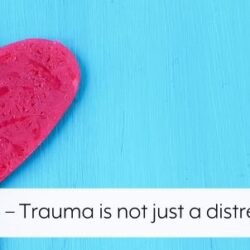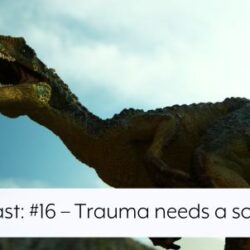
‘What can you do if a client can remember their trauma but only wants to talk about what is happening in the here-and-now?’
This was a question for a recent webinar Q&A, and it’s not a rare scenario. As trauma survivors, there are those of us who turn up in therapy and vomit everything out. We are urgent to be heard and seen and believed and, however much we try to slow things down, out comes our narrative: frantic, desperate, and painful.
And then there are those of us who turn up in therapy and avoid, avoid, avoid. The shame and the horror and the pain of what has happened to us pools heavily in our guts, like rich sticky tar trapped inside, and try as we might we cannot bear to bring it up and out and into words. It stays hidden within us, making us queasy and ill.
For the therapist, therapy may often ‘feel’ easier when as clients we splurge. Sitting with a client who is edging around their trauma all the time, not letting you in, not letting you near, not making the invisible visible or the unconscious conscious may be much harder. And yet of course avoidance rules the day – of course. After all, after trauma, avoidance is our default. The imprint of trauma in implicit memory stings hot with a warning to avoid: it says to us, ‘Don’t go there! Don’t remember!’ Why on earth would we want to go near it, to pick the weeping scab, to poke the inflamed nerve, when it’s evidently going to be so painful to do so? Left to trauma’s devices, I would happily distract away a whole session by talking about ‘Line of Duty’.
But on the whole I don’t distract forever, tempting though it is. Because I have made a commitment, by being in therapy, to do the work. The hard work. The soul-scraping hard work of facing the unfaceable, thinking the unthinkable, feeling the unfeelable. How far I’m willing to touch on painful topics in any given session, though, depends largely for me on the intersection of three principal factors:
- Do I have the capacity to be able to talk about this stuff?
- How confident am I that talking will be effective?
- And how safe do I feel in the therapeutic relationship?
1. The capacity to cope
So, firstly, then, do I have the capacity, right here, right now, to cope with the pain of this stuff? And sometimes we just don’t. We’re moving house, we’re having a baby, we’ve just been made redundant or we’re starting a new job, we’re getting divorced, we’re going through chemo, we’ve just been traumatised again … There are a million reasons why sometimes we just don’t have the resilience and the strength and the resource to go there with the heavy stuff. So many times I have wished that life would leave me alone for a while, just a little while, while I’m dealing with stuff from my childhood. But stuff in my adulthood appears alongside it, riding pillion, sometimes because of my childhood, sometimes just because evil and injustice and the random, chaotic, entropic nature of life means that shit continues to happen. Sometimes the trauma that I need to be dealing with manifests in the minutiae of the day-to-day, the week-to-week, and actually when I talk about those things in therapy I’m not avoiding the ‘heavy stuff’. Actually I’m sidling up to it, and using the day-to-day as an entry point to it. Sticking a toe in the water and seeing if it scalds.
Sometimes all we can do is manage week-to-week, and that’s okay. Sometimes there is enough pain and suffering in the week-to-week to take every second of every session just to process and deal with, and we feel like we’re drowning in the heaviness of today, let alone yesterday. We need a significant bit of brain space to be able to step back from fighting fires to wonder how the fire started and where the next point of flammability is. Our first skill, often, in therapy, is to learn how to put the fires out. So it can take a while before we can manage the chaos and the stress and the pressure – the senseless, relentless suffering of everyday life – and before we have the capacity to ‘go there’ with childhood trauma. And that’s okay.
2. Confidence that things will get better
How confident am I that talking about the trauma will actually make things better? This is reasonable to ask, as mostly as trauma survivors when we focus our attention back on the story, on the narrative of what happened, we are flooded again with trauma reactions: flashbacks, pain, distress, overwhelm, shame. Why would we put ourselves through the hell of processing this trauma if it’s only going to make things worse? Or if it’s going to make things unbearable? We need more hope, more encouragement, more certainty than that. We need to know that it’s going to help.
My principal aid in this regard has always been psychoeducation: to understand how trauma impacts the brain and the body; to grasp why talking about the trauma can make things worse; to know how to mitigate it; and ultimately to understand how we can be free of the impact of trauma through reconfiguring our memory, re-regulating the nervous system, and connecting up all the dissociated aspects of our experience again.
I’ve written that as a single sentence, but it’s a complex process. Understanding over many years of study and personal experience how recovery works, what the roadmap is, what kind of terrain to expect, where the shortcuts and the snarl-ups are: all of this has given me the confidence to face my trauma, because I know where I’m at in the journey. In Simon Sinek’s words, I’m starting with ‘why’. I know where I’m headed and I know that it will be worth it – knowledge that is absolutely vital when I’m overwhelmed again by the pain of trauma.
Often in my life I’ve been too quick to resignedly accept my suffering, and believe that nothing I do will relieve it. Of course I have: that belief was ingrained in me through years of powerlessness as a child, where whatever I did try – to stop the abuse, to be good enough, to be loved – was never effective. While I continue to believe that I have no agency in my life, that whatever I do will fail, then why would I be willing to come into therapy and unpick the scab? My belief is that I will be confronted by an incurable, oozing, pus-filled sore. So surely it’s better to keep the plaster on, avoid touching it, and accept that the best I can hope for is merely to manage my suffering, not relieve it?
But this belief system is a prediction of the future, not necessarily the future itself. And when I see that the powerlessness I’m feeling is a symptom of trauma, and not a rounded view of the world as it is and as it might be, then I’m much more willing to engage with the hard work of trauma processing. We all of us need to believe that our efforts are likely to be successful before we’re willing to endure the pain of remembering, and the pain of re-feeling.
3. A safe therapeutic relationship
And finally: how safe am I in the therapeutic relationship?
As clients so often we’re not willing to ‘go there’ simply because we don’t yet feel safe enough to. It’s easy to underestimate the need for this initial (and ongoing) phase of safety-making. And yet the whole reason that we’re in therapy is because we feel chronically unsafe – that’s what it means to be traumatised. Trauma is an experience of perceived or real life threat, something that threatens our core sense of safety. To be traumatised means that our brain and body have adapted to protect us from a reoccurrence, by developing a hyper-alertness for threat, and an intense, aversive feeling of unsafety.
It’s ironic though that many therapists fail to realise that their traumatised clients do in fact feel chronically unsafe. Often we’ve learned to mask it. Often we can’t put words to it. Often it’s simply our default, and we label these symptoms of unsafety as ‘mental illness’ rather than attributing them to trauma. But we can only really ‘go there’ in the therapy room once we feel relationally held, and our emotions contained, and our shame modulated.
And that’s not an easy thing to achieve: how on earth can we feel safe with the therapist when our early attachment experiences were with people who were so fundamentally unsafe? Our brains predict the same again. We approach and avoid all at the same time – what technically is called disorganised attachment. The therapist is both the most safe and the most unsafe person in the world. The most sought after, but the most triggering. The best and the worst person to process trauma with.
So it’s not surprising when we hold back and don’t want to go there yet. Very often, in my experience, therapists want to rush into trauma processing: ‘to get on with the work’, especially if sessions are limited. But the narrative of ‘what happened’ isn’t actually the main point of trauma therapy. The main point is learning to feel safe again. Pushing a client to talk about what happened before they feel safe in the therapeutic relationship – with all the complications, all the two steps forwards and seven steps back of disorganised attachment – is so often simply counterproductive.
Instead we need to patiently do the steady work of building, building, building safety: week after week after week. This is not wasted time: it is the core of the work. If we believe that trauma is healed simply by talking about it, then of course we’ll want to rush on to get to the narrative, to the ‘what happened’. But we need to recognise that trauma – the body and brain’s response to chronic and overwhelming unsafety – is healed by being able to feel safe again, and that we talk about it in order to facilitate that process, but not as an end in itself.
We need to do the work. Of course we do. Because healing doesn’t come through avoidance. Healing doesn’t come as a byproduct of time. Healing doesn’t come because we are forced to ‘forgive and forget’. Healing comes when we do the work. But there are good reasons why we don’t want to dive in – reasons that need to be understood and respected and validated. We need to have the capacity, we need to believe it’s going to be effective, and we need to have the trust. Safety first.



7 Comments
Thank you for sharing this. I am a therapist working with trauma survivors and its really important to be taught this.
Again fantastic clarity
Thank you Caroline.
Am going to share this blog in my newsletter
Thank you Carolyn – as a counsellor working with a client who is not ready to dive in, this is just what I needed to read – patience and safety first.
I am currently working on the telephone with a client who speaks as several different parts. One, a child, wants to tell me about what happened as if re-experiencing. Another, adult persona, says all the talking must stop. I believe that all the parts are doing what they can to help the client so I am trying to balance the different pressures. The client is finding relief so I think I must be doing something right but I feel I am working from instinct not in the skilled, knowledgeable way you describe despite years of experience.
I have several clients working around their trauma. I do not expect or require them to talk about their trauma itself. I frame it to them that it is not the trauma that does the damage but what we do with it afterwards, how others deal with it and what parts of it we carry with us into later life. Clients can work through the shame and embarrassment, the awfulness of not being believed, and the attempts to hide and bury it all without sharing any of the gory details with me. Work can also be done around the time before the trauma. here they may harbour buried feelings that they brought it on themselves and were to blame.
They may share only a fleeting glimpse of the traumatic event but in my experience they gain a great deal from exploring in depth the impact it has had upon their life.
My therapist(s) never wanted me to discuss trauma. I really needed to! When I finally got tired of them avoiding the subject I finally asked the last one why we never discussed it. She said because she had a bad experience with another patient and that patient regressed into a dark place! But that wasn’t me, so I never went back. I told her she was too “soft”, meaning I don’t think she could handle dealing with other people’s trauma! Still haven’t found anyone I can talk to about it! I’m sure when it drives me over the edge I’ll try again.
Wish all therapists knew this. Instead of talking about what happened, all mine wanted to do was talk about here and now and why I do the things I do now. Nothing about what happened. Instead I felt I needed to ignore what happened as it had no impact on why I needed help.